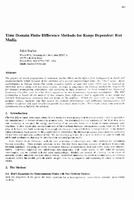Time domain finite difference methods for range dependent Biot media

Abstract
The physics of sound propagation in saturated, porous (Biot) media differs from propagation in fluids and elastic/anelastic solids because of the existence of a second compressional wave, the "slow" wave. Many environments in bottom interacting ocean acoustics consist of mud and sands which can be modeled as saturated, porous solids with low shear moduli. In order to understand the physical mechanrsms responsible for acoustic propagation, attenuatron, and scattering in these processes, we have extended our Numerical Scattering Chamber code to solve Biot's equations in two dimensional Cartesian coordinates. The NSC formulation is based on the method of time domain finite differences and is applicable to the rough and laterally heterogeneous structures that are found on the seafloor. Within the same code we can compare acoustic, elastic, anelastic and Biot models for realistic environments with subbottom heterogeneities and seafloor roughness with scale lengths comparable to acoustic wavelengths.A11 multiple interactions and mode conversions are included in the solution.
Report Number
CP-45Source
In: High Frequency Seafloor Acoustics (SACLANTCEN Conference Proceedings CP-45), 1997, pp. 501-508Date
1997Author(s)
Stephen, Ralph